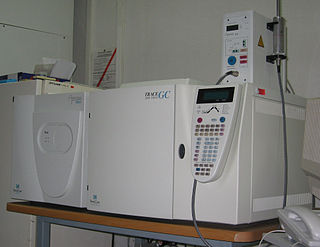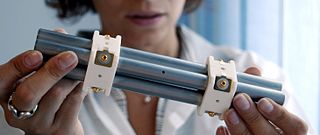Tandem means an arrangement one behind another as opposed to side by side.
Contents
Tandem may also refer to:
Tandem means an arrangement one behind another as opposed to side by side.
Tandem may also refer to:
An atlas is a collection of maps.
ABC are the first three letters of the Latin script.
BNC may refer to:
Accelerator may refer to:
TMS may refer to:
APC most often refers to:

Mass spectrometry (MS) is an analytical technique that is used to measure the mass-to-charge ratio of ions. The results are presented as a mass spectrum, a plot of intensity as a function of the mass-to-charge ratio. Mass spectrometry is used in many different fields and is applied to pure samples as well as complex mixtures.
ACC most often refers to:
Alice may refer to:
Hybrid may refer to:

Tandem mass spectrometry, also known as MS/MS or MS2, is a technique in instrumental analysis where two or more stages of analysis using one or more mass analyzer are performed with an additional reaction step in between these analyses to increase their abilities to analyse chemical samples. A common use of tandem MS is the analysis of biomolecules, such as proteins and peptides.

Gas chromatography–mass spectrometry (GC–MS) is an analytical method that combines the features of gas-chromatography and mass spectrometry to identify different substances within a test sample. Applications of GC–MS include drug detection, fire investigation, environmental analysis, explosives investigation, food and flavor analysis, and identification of unknown samples, including that of material samples obtained from planet Mars during probe missions as early as the 1970s. GC–MS can also be used in airport security to detect substances in luggage or on human beings. Additionally, it can identify trace elements in materials that were previously thought to have disintegrated beyond identification. Like liquid chromatography–mass spectrometry, it allows analysis and detection even of tiny amounts of a substance.

In mass spectrometry, the quadrupole mass analyzer is a type of mass analyzer originally conceived by Nobel laureate Wolfgang Paul and his student Helmut Steinwedel. As the name implies, it consists of four cylindrical rods, set parallel to each other. In a quadrupole mass spectrometer (QMS) the quadrupole is the mass analyzer – the component of the instrument responsible for selecting sample ions based on their mass-to-charge ratio (m/z). Ions are separated in a quadrupole based on the stability of their trajectories in the oscillating electric fields that are applied to the rods.

Oki Electric Industry Co., Ltd., commonly referred to as OKI, OKI Electric or the OKI Group, is a Japanese information and communications technology company, headquartered in Toranomon, Minato-ku, Tokyo and operating in over 120 countries around the world.
D is the fourth letter of the Latin alphabet.
DTA may refer to:
Cem Sultan (1459–1495) was a prince of the Ottoman Empire.

A triple quadrupole mass spectrometer (TQMS), is a tandem mass spectrometer consisting of two quadrupole mass analyzers in series, with a (non-mass-resolving) radio frequency (RF)–only quadrupole between them to act as a cell for collision-induced dissociation. This configuration is often abbreviated QqQ, here Q1q2Q3.

An electrostatic particle accelerator is a particle accelerator in which charged particles are accelerated to a high energy by a static high voltage potential. This contrasts with the other major category of particle accelerator, oscillating field particle accelerators, in which the particles are accelerated by oscillating electric fields.
In mass spectrometry, de novo peptide sequencing is the method in which a peptide amino acid sequence is determined from tandem mass spectrometry.